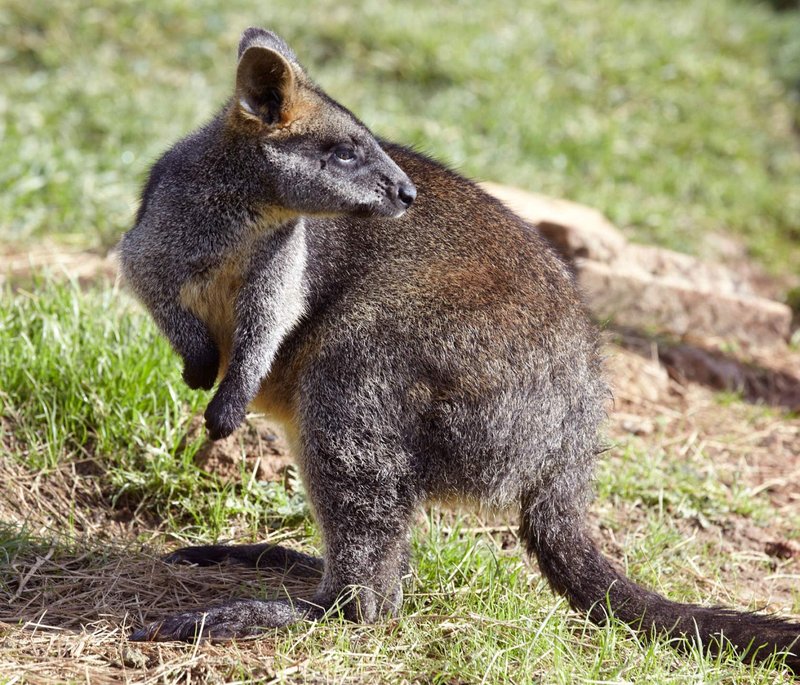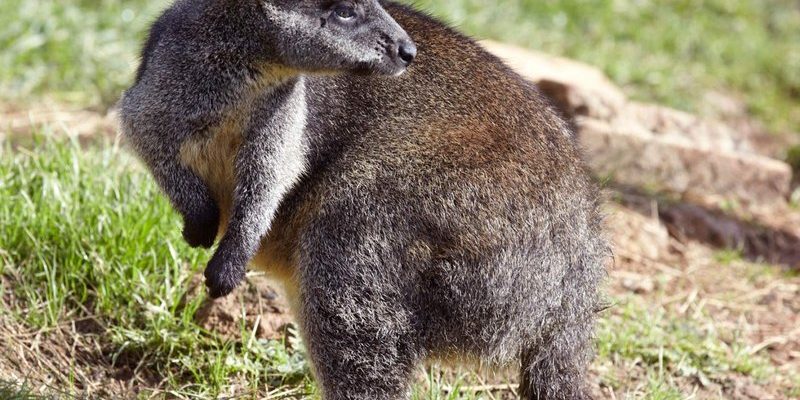
You might be wondering why these wallabies deserve a spot in your daily wildlife trivia. Well, they’re not just cute; they have unique adaptations and behaviors that make them quite special in the animal kingdom. So, grab a cup of coffee, and let’s dive into some intriguing facts about the swamp wallaby!
1. The Swamp Wallaby’s Unique Habitat
Swamp wallabies, also known as *Wallabia bicolor*, thrive in dense forests and swamps across eastern Australia. Unlike their larger kangaroo relatives, these little guys prefer environments where they can hide and seek food without being too exposed. Picture a cozy nook in the woods with a bit of water nearby—that’s their perfect home.
These habitats provide them with plenty of leafy greens, which are their primary food source. You might be surprised to learn that swamp wallabies are browsers, meaning they munch on shrubs and trees rather than grazing on grasses. This diet helps them stay hidden from predators, taking advantage of their surroundings to blend in with nature.
2. A Unique Feeding Behavior
Speaking of food, swamp wallabies have an interesting way of eating that sets them apart. Their diet mainly consists of leaves, fruits, and flowers, making them quite the picky eaters! Unlike some other wallabies, swamp wallabies have strong molar teeth that allow them to grind down tough vegetation efficiently.
Here’s the thing: they often lead a solitary lifestyle, munching away on their own. You might spot them during dusk or dawn, as they are crepuscular animals. This means they’re most active during the twilight hours. It’s a strategic choice to avoid the heat of the day and to dodge potential predators like dingoes or eagles.
3. Size and Appearance
Swamp wallabies are relatively small compared to other wallabies and kangaroos. They typically weigh between 15–30 pounds and stand about two to three feet tall. Their fur is dense and can range from a reddish-brown to dark gray, which helps them camouflage perfectly in their swampy surroundings.
What’s even cuter? They have a distinctive long, muscular tail that assists them in balancing as they hop and navigate through the underbrush. Honestly, when you see them bounding through the trees, you might think they’re little furry acrobats, gracefully maneuvering their way around obstacles.
4. Social Creatures with Individual Personalities
While swamp wallabies are generally solitary, that doesn’t mean they shy away from social interactions. They often communicate through a series of grunts and low sounds, indicating their feelings and intentions. Imagine them holding a little chat with their neighbors!
Interestingly, they can recognize each other’s calls and will respond accordingly. This social behavior is especially noticeable in areas where food is plentiful. When resources are abundant, they can tolerate being around others, making for some interesting interactions. It’s like a little community of wallabies sharing a meal together!
5. The Swamp Wallaby’s Reproduction and Young
When it comes to reproduction, swamp wallabies are quite the dedicated parents. They typically give birth to a single joey, which they carry in their pouch for about six months. This pouch is not just for show; it provides a safe haven where the tiny joey can grow and stay protected from predators and the elements.
Once the joey is ready to explore, it will peek out of the pouch and gradually start venturing outside. It’s a heartwarming sight to see the little one learning the ropes of wallaby life, hopping beside its mom as it gathers the courage to explore the world on its own.
6. Adaptations to a Semi-Aquatic Lifestyle
One of the most fascinating aspects of swamp wallabies is their adaptability to a semi-aquatic lifestyle. Unlike many terrestrial marsupials, these wallabies are often found near water sources, and they’re not afraid of getting their feet wet!
Their webbed toes aren’t just for show; they help them navigate through muddy terrains and wetlands effortlessly. This adaptation allows them to escape from predators and find food in areas that many other animals wouldn’t dare venture. It’s like they’re the ultimate aquatic explorers in the animal kingdom!
7. Environmental Importance
Swamp wallabies play a crucial role in their ecosystem. By browsing on various plants, they help control vegetation growth, which can prevent overgrowth and maintain the balance of their habitats. You might wonder why that matters—well, it supports biodiversity!
By keeping the plant life in check, they allow other species to thrive. This balance is essential for ensuring that the ecosystem remains healthy and functional. So, the next time you think about swamp wallabies, remember that they’re not just adorable creatures; they’re vital players in the grand scheme of nature.
8. Conservation Status
Unfortunately, like many wildlife species, swamp wallabies face threats from habitat loss and human activity. Urban development and agriculture have encroached on their natural habitats, leading to declining populations in some areas.
Efforts to protect these vibrant creatures include habitat restoration and creating wildlife corridors. Conservationists are working hard to ensure that swamp wallabies have safe spaces to live and thrive. That means more opportunities for future generations to appreciate these amazing animals!
9. A Unique Adaptation: The “Swampy” Hop
Want to know something cool about how swamp wallabies move? They have a distinct way of hopping that seems to be a bit more bouncy than other wallabies. This unique “swampy” hop helps them navigate through their wetland homes with ease.
Their powerful back legs allow them to leap over logs and splashes of mud, making them little pros at maneuvering through tricky terrains. Think of them as nature’s ballet dancers, gracefully leaping in and out of their watery playgrounds!
10. Fun Folklore and Cultural Significance
Finally, let’s not forget about the swamp wallaby’s place in Australian folklore. These creatures have been featured in Aboriginal stories and art, often symbolizing resilience and adaptability. Their playful nature and unique appearance make them memorable characters in these cultural narratives.
If you ever visit Australia, keep an eye out for their representation in local art or crafts! Connecting with the swamp wallaby through these stories can deepen your appreciation for them and the rich cultural heritage of the region.
In summary, swamp wallabies are truly remarkable creatures, each aspect of their lives—from their unique adaptations to their importance in the ecosystem—paints a picture of wildlife that’s both charming and vital. Next time you think of a wallaby, remember the swamp wallaby and its fascinating world. They might just inspire you to take a closer look at the wildlife around you!

